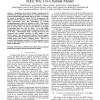Free Online Productivity Tools
i2Speak
i2Symbol
i2OCR
iTex2Img
iWeb2Print
iWeb2Shot
i2Type
iPdf2Split
iPdf2Merge
i2Bopomofo
i2Arabic
i2Style
i2Image
i2PDF
iLatex2Rtf
Sci2ools
GLOBECOM
2010
IEEE
2010
IEEE
Investigation into the Doppler Component of the IEEE 802.11n Channel Model
-- Simulations show that the Doppler component of the IEEE 802.11n channel model results in a dramatic decrease in transmit beamforming gain within only 20 ms delay, even though the model is intended for indoor WLAN environment with stationary devices. However, new measurements collected in an office environment show that degradation to transmit beamforming gain is much less sensitive to delay. With normal environmental conditions in the office environment, it was found that on average there was only a 22% decrease in transmit beamforming gain after 200 ms delay. Even with highly exaggerated motion, reasonable gain is maintained with over 100 ms of delay. Measurements with a moving device were also conducted with resulting sensitivity to delay similar to the 802.11n model. The measurements indicate that the Doppler component of the 802.11n channel model is more comparable to a moving device rather than a stationary device. The use of transmit beamforming in an indoor WLAN environment i...
| Added | 11 Feb 2011 |
| Updated | 11 Feb 2011 |
| Type | Journal |
| Year | 2010 |
| Where | GLOBECOM |
| Authors | Eldad Perahia, Anmol Sheth, Thomas Kenney, Robert Stacey, Daniel Halperin |
Comments (0)

